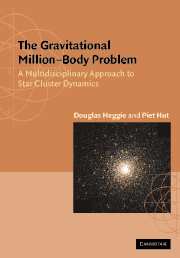Book contents
- Frontmatter
- Contents
- Preface
- PART I INTRODUCTIONS
- PART II THE CONTINUUM LIMIT: N → ∞
- PART III MEAN FIELD DYNAMICS: N = 106
- PART IV MICROPHYSICS: N = 2
- PART V GRAVOTHERMODYNAMICS: N = 106
- PART VI GRAVITATIONAL SCATTERING: N = 3
- PART VII PRIMORDIAL BINARIES: N = 4
- PART VIII POST-COLLAPSE EVOLUTION: N = 106
- PART IX STAR CLUSTER ECOLOGY
- Appendix A A Simple N-Body Integrator
- Appendix B Hints to Solution of Problems
- References
- Index
PART VIII - POST-COLLAPSE EVOLUTION: N = 106
Published online by Cambridge University Press: 05 June 2012
- Frontmatter
- Contents
- Preface
- PART I INTRODUCTIONS
- PART II THE CONTINUUM LIMIT: N → ∞
- PART III MEAN FIELD DYNAMICS: N = 106
- PART IV MICROPHYSICS: N = 2
- PART V GRAVOTHERMODYNAMICS: N = 106
- PART VI GRAVITATIONAL SCATTERING: N = 3
- PART VII PRIMORDIAL BINARIES: N = 4
- PART VIII POST-COLLAPSE EVOLUTION: N = 106
- PART IX STAR CLUSTER ECOLOGY
- Appendix A A Simple N-Body Integrator
- Appendix B Hints to Solution of Problems
- References
- Index
Summary
The following three chapters complete the story of the evolution of a million-body system, in its purely stellar dynamical form. Chapter 27 begins by estimating the rate at which the formation and evolution of (non-primordial) binaries effectively generates energy within the system. The first application is to show that this is sufficient to halt core collapse. Then we consider other ways of generating the energy: binaries formed in dissipative two-body encounters between single stars, and primordial binaries; we quantify the extent to which the effectiveness of primordial binaries depends on their abundance and their energy.
In Chapter 28 we consider how a balance can be struck between the creation of energy (by binary interactions) deep in the core and the large-scale structure of the rest of the cluster. We first describe a standard argument which implies that conditions in the core, where the energy is generated, are governed by the overall structure. We outline the core parameters and overall evolution which this argument implies. Next we give arguments to show that this balance can be unstable, and describe the phenomenon of temperature inversion which is associated with the generation of gravothermal oscillations. The manner in which they depend on N (in idealised models) is an example of a Feigenbaum sequence of ‘period-doubling bifurcations’ in this context.
Chapter 29 rounds off the evolution of a million-body system by focusing on the evolution of gross structural parameters: total mass, and a measure of the overall radius.
- Type
- Chapter
- Information
- The Gravitational Million–Body ProblemA Multidisciplinary Approach to Star Cluster Dynamics, pp. 253Publisher: Cambridge University PressPrint publication year: 2003



